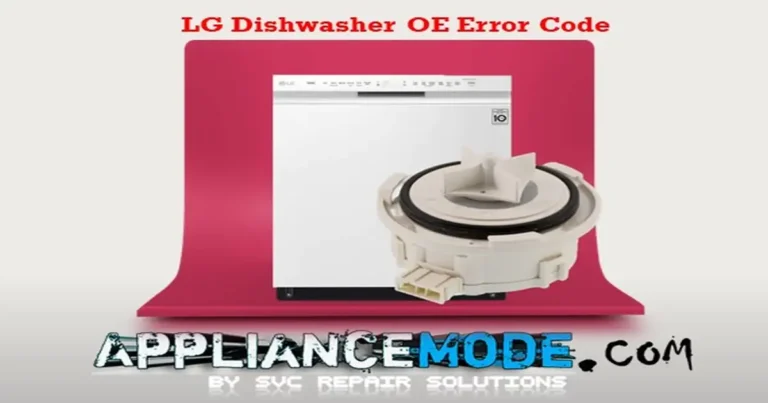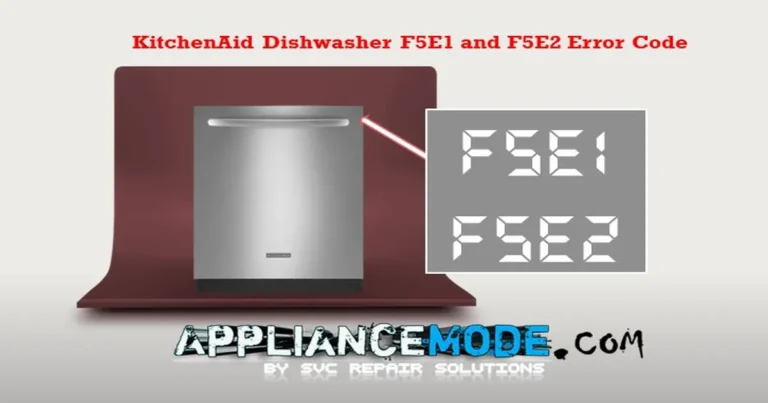Is your Smeg dishwasher flashing an error code instead of sparkling clean dishes? Don’t stress! This guide translates those codes, uncovers simple fixes, and helps you decide when to call in reinforcements.

Inside, you’ll find:
- Common code meanings: decipher those cryptic messages like a pro.
- Troubleshooting tips: Try these DIY solutions before dialing for help.
Let’s tackle those error codes and get your dishwasher back to its dishwashing duties!
SMEG Dishwasher Error Codes
E1: water leak error
An E1 alarm indicates a potential flood condition. The alarm is triggered when the flood prevention floating switch detects water in the basin and remains in a closed state for more than 5 seconds.
Possible causes:
- The presence of water in the basin is due to water leaks from the tub, the aqua-stop hose, components in the base (wash pump, drainage pump, softener unit, etc.), and from the connection hose.
- The flood prevention system float, due to incorrect positioning, keeps the switch “closed.”.
- Defective flood prevention system switch.
- Electrical connections were carried out poorly.
- Defective timer board.
Solutions:
- Empty the basin of water in order to restore the float to its normal operating position. Determine where the leak occurs by operating the dishwasher.
- Reposition the flood prevention system correctly so that the float returns to the normal operating position.
- Check the correct operation of the switch.
- Ensure that the electrical connections are correct (in accordance with the electrical diagram) and properly carried out on both the flood prevention system and the timer board. Using an electrical tester set to the “ohm” position, check the electrical continuity of the connections as shown on the electrical diagram. Restore any defective connections.
- Once it is ascertained that none of the above causes have occurred, you must ensure that the defect is due to the timer board. Turn on the dishwasher and set a new cycle. The dishwasher will immediately begin to drain for 3 minutes. If the error appears, it means that the PCB is defective. Replace the electronic board.
E3: Heater error
The dishwasher is having trouble heating the water properly. An E3 alarm will occur if the water temperature increase is too slow, taking more than 20 minutes to rise just 1.5°C.
Causes:
- Defective heating element.
- Electrical connections were carried out poorly.
- Faulty wash pump
- Defective electronic board.
Solutions:
- Check the condition of the heating element. With the aid of an electrical tester, set a resistance measurement that should read about 25 ohms. If the measurement indicates “open,” the heating element is defective; therefore, replace it.
- Check that the electrical connections are inserted well, both on the heating element and the electronic board. Using an electrical tester set to the “ohm” position, check the electrical continuity of the connections. Restore any defective connections.
- If the wash pump does not work, water does not circulate, and therefore there will be no heating in the tub. Replace the wash pump and check the condition of the heating element.
- In the event that the previous possibilities were checked with negative results, it is likely that the relay on the electronic board is defective. In this case, the voltage at the ends of the heating element should be monitored with a multimeter in the heating phase. In fact, during the heating phase, there should be 220 volts at the heating element terminals. This voltage must be monitored for a certain amount of time so that the relay can work properly on activation, and then the problem could occur only after a few minutes of operation. In this case, replace the timer board.
E4: Temperature probe error
The E4 alarm indicates a problem with the dishwasher’s temperature probe. This probe normally monitors the water temperature during operation. The alarm usually occurs at startup if the probe is disconnected or has a short circuit.
Causes:
- Electrical connections were carried out poorly.
- Defective temperature probe.
- Electronic boards do not detect temperature variations.
The fix:
- Check that the electrical connections are correctly carried out both on the probe and on the timer board. Also check the electrical continuity of these connections. Restore any defective connections.
- Use your multimeter to measure the resistance value at the probe terminals. It should be approximately 11.5 kiloohm at 25°C. If an open circuit is detected, the probe is defective and should therefore be replaced.
- In the event that the previous possibilities were checked with negative results, the timer board does not detect temperature variations and therefore is defective. Replace the timer board.
E5: Inlet valve error
The E5 alarm indicates the dishwasher is having trouble filling with water. This usually happens during the initial stages of a cycle when the water level inside the dishwasher isn’t reached within a set time (typically around 9 minutes).
There are several reasons why this might occur:
- Closed Water Supply: Make sure the water supply valve to the dishwasher is turned on fully.
- Clogged Filter or Drain Hose: Food scraps or debris might be blocking the water intake.
- Kinked Hose: Check if the dishwasher’s inlet hose is bent or kinked, restricting water flow.
- Faulty Solenoid Valve: In rare cases, the valve controlling water flow might be malfunctioning.
E6: Drain pump error
The E6 alarm indicates the dishwasher is having trouble draining the wash water. This typically occurs during the draining cycle if the water isn’t removed from the dishwasher tub within a set time limit (usually around 4 minutes).
Several factors can contribute to this issue:
- The drainage hose is positioned improperly, obstructed, or squeezed.
- Defective level pressure switch.
- The drainage pump is defective or clogged.
- Drainage pump electrical connections were carried out poorly.
- The electronic board does not activate the drainage pump or detect the level signal.
Troublshooting steps:
- Clean the Drain Filter: Locate and clean the dishwasher’s drain filter according to your user manual.
- Inspect the Drain Hose: Check the drain hose for clogs or kinks and straighten any bends.
- Reset the Dishwasher: Sometimes a simple reset can resolve temporary glitches. Consult your user manual for specific reset instructions for your model.
- Drain Pump and Level Pressure Switch: The manual might guide you on how to check the drain pump and level pressure switch using a tester. A faulty switch or pump might need replacement.
- Electrical Connections: The manual might have instructions on verifying proper connections between the drain pump and the electronic board using a tester. Fix any loose or faulty connections.
- Electronic Board: In rare cases, the issue might lie with the electronic board. If the pump works but the error persists, the board might need replacement.
E7: Water liter counter error.
The E7 alarm indicates a potential issue with the dishwasher’s flow meter turbine. This component monitors water usage during the cycle.
While the dishwasher might still complete the cycle even with a faulty flow meter turbine, this alarm is a warning. It’s recommended to address this issue to ensure optimal water usage and performance.
Causes:
- Damaged electrical connections were carried out poorly.
- Faulty flow meter “reed switch”.
- Turbine blocked.
- Electronic boards do not detect the signal from the turbine.
Solutions:
- Check that the turbine and electronic board electrical connections are carried out properly. Using an electrical tester set to the “ohm” position, check the electrical continuity of the connections as shown on the electrical diagram. Restore any defective connections.
- Remove the block; if possible, replace the component.
- In the event that the previous possibilities were checked with negative results, the timer board does not detect the signal variation from the turbine and therefore is defective. Replace the timer board.
E8: Alternating valve error.
This alarm applies to dishwashers with two wash arms (often called an “alternating wash” system). The E8 alarm indicates a potential problem with the valve that controls water flow between the upper and lower wash arms.
The dishwasher might still finish a cycle with a faulty Alternating or diverter valve, but the dishes may not be cleaned as effectively.
Causes:
- Alternating valve electrical connections were carried out poorly.
- Defective alternating valve.
- Electronic boards do not power the alternating valve motor or detect the positioning signal.
Solutions:
- Check that the alternating valve and electronic board electrical connections are carried out properly. Using an electrical tester set to the “ohm” position, check the electrical continuity of the connections as shown on the electrical diagram. Restore any defective connections.
- Check the operation of the motor, powering it with 220 Vac, and ensure that it works without crackling. Check that the internal gears that can be seen turn freely. If defective, replace the alternating valve.
- To verify the alternating valve’s operation and diagnose potential issues, follow these steps:
- Confirm power supply:
- Using a multimeter, measure the voltage at the valve’s power connections when it should be activated.
- Ensure 220 Vac is present, indicating a proper power supply.
- Initiate the test cycle:
- Activate the dishwasher’s test cycle to directly observe the valve’s functionality.
- The alternating valve is typically energized at the start of each test cycle, allowing for a clear assessment.
- Assess valve and motor function:
- Visually inspect the valve’s movement during the test cycle to confirm its operation.
- Listen for any unusual sounds that may suggest mechanical issues.
- Isolate faulty components:
- If the valve functions correctly during the test cycle but the board fails to detect its positioning signal, it likely indicates a faulty timer board.
- In this case, replacement of the timer board is necessary.
- Confirm power supply:
E2/E9 Alarms: Pressure switch error (Dishwashers with Flow Meter)
These alarms (E2 or E9, depending on the model) indicate a potential problem with the amount of water entering the dishwasher. This typically occurs in dishwashers equipped with a flow meter that monitors water usage.
The alarms might activate if the flow meter detects less water than expected during the filling cycle.
Possible reasons for low water intake:
- Closed water supply: Make sure the water supply valve to the dishwasher is fully open.
- Clogged filter or hose: Food scraps or debris might be blocking the water intake.
- Kinked hose: Check if the dishwasher’s inlet hose is bent or kinked, restricting water flow.
- Leaks: Leaking of water from the tub
- Faulty flow meter: In rare cases, the flow meter itself might be malfunctioning.
What to do:
- Check the Water Supply: Ensure the water supply valve to the dishwasher is open.
- Clean the Filter: Locate and clean the dishwasher’s filter according to your user manual.
- Inspect the Inlet Hose: Straighten any kinks or bends in the dishwasher’s inlet hose.
- Check that the water inlet valve does not stay open or draw.
- Check the pressure switch.
- Leaks invastigation: Check that there are no leaks from the tub.
E10: Turbidity sensor error
The E10 alarm typically won’t occur during regular use, but it might appear during a diagnostic test cycle if the electronic timer detects a disconnected turbidity sensor.
This alarm applies only to dishwashers equipped with a turbidity sensor. The sensor monitors water cleanliness during the wash cycle.
Causes:
- Electrical connections were carried out poorly.
- Electronic boards do not detect the signal from the sensor.
What to do:
- If you haven’t had recent maintenance, the E10 alarm during a test cycle might be a fluke. You can try running a normal wash cycle and see if the issue persists.
- Check that the electrical connections are correctly carried out both on the sensor and on the timer board. Also check the electrical continuity of these connections. Restore any defective connections.
- In the event that the previous possibilities were checked with negative results, the timer board does not detect the signal from the sensor and therefore is defective. Replace the timer board.
E11: BLDC washing pump error.
This alarm indicates an issue with the washing pump in your Smeg dishwasher. The washing pump is responsible for circulating water during the wash cycle.

I am a master Appliance Repair technician with over 35 years of experience in the field. I am passionate about helping people troubleshoot their appliances and fix common problems. My website, appliancemode.com, provides a wealth of information on troubleshooting common appliance issues and deciphering error codes. This website aims to empower people to tackle appliance repairs themselves and save money on service calls.



